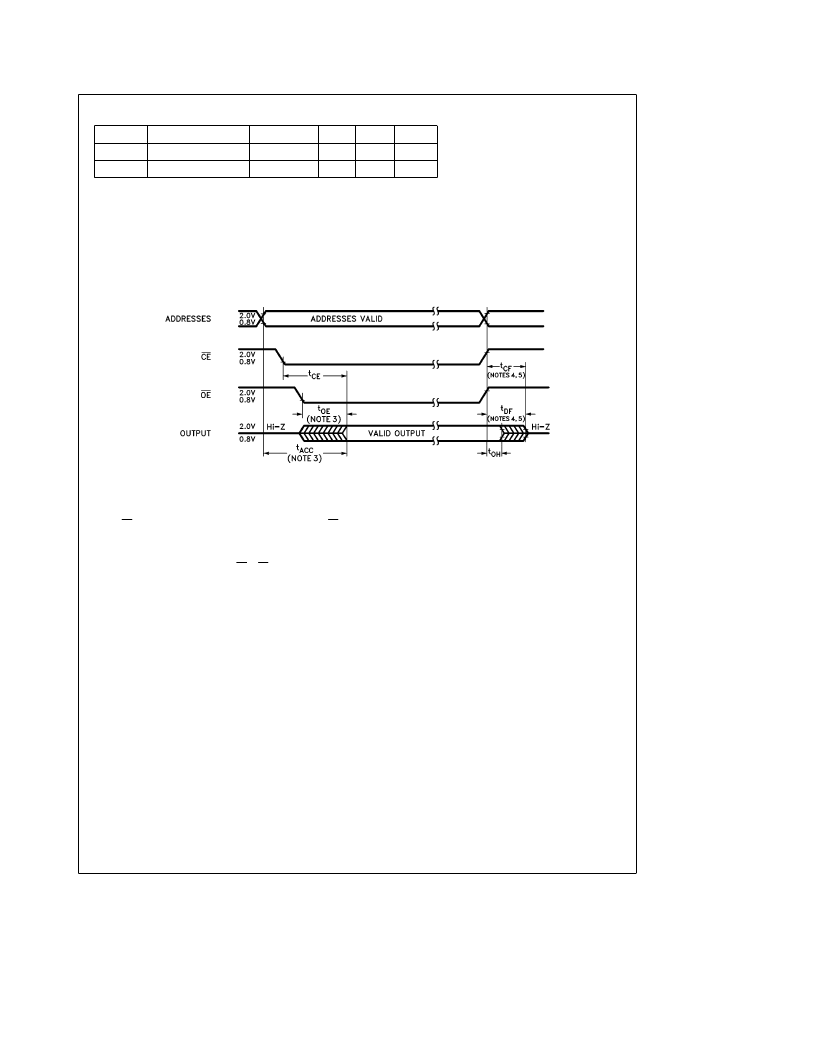- 您現(xiàn)在的位置:買賣IC網(wǎng) > PDF目錄371424 > 27C256 (National Semiconductor Corporation) 262,144-Bit (32K x 8) High Performance CMOS EPROM PDF資料下載
參數(shù)資料
| 型號(hào): | 27C256 |
| 廠商: | National Semiconductor Corporation |
| 英文描述: | 262,144-Bit (32K x 8) High Performance CMOS EPROM |
| 中文描述: | 262,144位(32K的× 8)高性能CMOS存儲(chǔ)器 |
| 文件頁(yè)數(shù): | 4/12頁(yè) |
| 文件大小: | 182K |
| 代理商: | 27C256 |

Capacitance
T
A
e a
25
§
C, f
e
1 MHz (Note 2)
Symbol
Parameter
Conditions
Typ
Max
Units
C
IN
Input Capacitance
V
IN
e
0V
6
12
pF
C
OUT
Output Capacitance
V
OUT
e
0V
9
12
pF
AC Test Conditions
Output Load
1 TTL Gate and
C
L
e
100 pF (Note 8)
Input Rise and Fall Times
s
5 ns
Input Pulse Levels
0.45 to 2.4V
Timing Measurement Reference Level
Inputs
Outputs
(Note 10)
0.8V and 2.0V
0.8V and 2.0V
AC Waveforms
(Notes 6, 7 and 9)
TL/D/10833–4
Note 1:
Stresses above those listed under ‘‘Absolute Maximum Ratings’’ may cause permanent damage to the device. This is stress rating only and functional
operation of the device at these or any other conditions above those indicated in the operational sections of this specification is not implied. Exposure to absolute
maximum rating conditions for extended periods may affect device reliability.
Note 2:
This parameter is only sampled and is not 100% tested.
Note 3:
OE may be delayed up to t
ACC
b
t
OE
after the falling edge of CE without impacting t
ACC
.
Note 4:
The t
DF
and t
CF
compare level is determined as follows:
High to TRI-STATE
é
, the measured V
OH1
(DC)
b
0.10V;
Low to TRI-STATE, the measured V
OL1
(DC)
a
0.10V.
Note 5:
TRI-STATE may be attained using OE or CE.
Note 6:
The power switching characteristics of EPROMs require careful device decoupling. It is recommended that at least a 0.1
m
F ceramic capacitor be used on
every device between V
CC
and GND.
Note 7:
The outputs must be restricted to V
CC
a
1.0V to avoid latch-up and device damage.
Note 8:
TTL Gate: I
OL
e
1.6 mA, I
OH
e b
400
m
A.
C
L
e
100 pF includes fixture capacitance.
Note 9:
V
PP
may be connected to V
CC
except during programming.
Note 10:
Inputs and outputs can undershoot to
b
2.0V for 20 ns Max.
Note 11:
CMOS inputs: V
IL
e
GND
g
0.3V, V
IH
e
V
CC
g
0.3V.
4
相關(guān)PDF資料 |
PDF描述 |
|---|---|
| 27C256-90ITS | 256K (32K x 8) CMOS EPROM |
| 27C256-10ITS | 256K (32K x 8) CMOS EPROM |
| 27C256-20ITS | 256K (32K x 8) CMOS EPROM |
| 27C256-15EVS | 256K (32K x 8) CMOS EPROM |
| 27C256-10EVS | 256K (32K x 8) CMOS EPROM |
相關(guān)代理商/技術(shù)參數(shù) |
參數(shù)描述 |
|---|---|
| 27C256 WAF | 制造商:Intel 功能描述: 制造商:Microchip Technology Inc 功能描述: |
| 27C256/BUA-20 | 制造商:未知廠家 制造商全稱:未知廠家 功能描述:x8 EPROM |
| 27C256/BUA-25 | 制造商:未知廠家 制造商全稱:未知廠家 功能描述:x8 EPROM |
| 27C256/BXA-20 | 制造商:未知廠家 制造商全稱:未知廠家 功能描述:x8 EPROM |
| 27C256/BXA25 | 制造商: 功能描述: 制造商:undefined 功能描述: |
發(fā)布緊急采購(gòu),3分鐘左右您將得到回復(fù)。